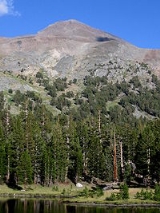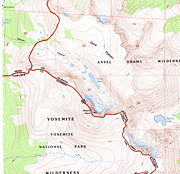
Mount Dana
Encyclopedia
Mount Dana is a mountain
on the eastern edge of Yosemite National Park
in the U.S. state
of California
. At an elevation of 13061 feet (3,981 m), it is the second highest mountain in Yosemite (after Mount Lyell). Mount Dana is the highest peak in Yosemite that is a simple hike to the summit. Mount Dana is named after James Dwight Dana
, who was a professor of geology
at Yale College
.
Mount Dana is composed of prebatholithic rock that is mostly reddish metamorphic rock
, which was composed by metavolcanics of surfacing magma from the Mesozoic Era.
Mount Dana's northern face includes a small, receding glacier known as the Dana Glacier
. The Dana Meadows
lie at the foot of the mountain. From the top, lakes throughout Dana Meadows, Mono Lake
, and many other mountains are in view.
 There is a clearly marked path leading just above tree line. After topping a ridge, a set of use-paths and ducked routes are present, with the main path running along the easterly ridgeline. Additionally, numerous alternate trail segments begin and end at various points on the southwestern face, making parts of this hike a difficult class 2. The path segments turn into scree
There is a clearly marked path leading just above tree line. After topping a ridge, a set of use-paths and ducked routes are present, with the main path running along the easterly ridgeline. Additionally, numerous alternate trail segments begin and end at various points on the southwestern face, making parts of this hike a difficult class 2. The path segments turn into scree
toward the summit, where a shallow stone-walled shelter and register are found. Significant snow fields on the mountain slopes can exist late into the summer season. Total round trip hiking time can be anywhere between 3 and 12 hours depending many factors, such as acclimatization to elevation.
After reaching a plateau above the tree line, almost all vegetation disappears with the exception of lichen
and a few high alpine Sky Pilot
(Polemonium eximium
). Fauna
are largely limited to spiders and insects, such as black/brown grasshopper
s. The only mammal
s other than humans are marmot
s and American Pika
s which are lagomorphs related to rabbits.
Thunderstorm
s are known to arise suddenly, making the rocks slippery, and the hiking dangerous year round.
Even experienced hikers can face altitude sickness
, due to the high elevation.

Mountain
Image:Himalaya_annotated.jpg|thumb|right|The Himalayan mountain range with Mount Everestrect 58 14 160 49 Chomo Lonzorect 200 28 335 52 Makalurect 378 24 566 45 Mount Everestrect 188 581 920 656 Tibetan Plateaurect 250 406 340 427 Rong River...
on the eastern edge of Yosemite National Park
Yosemite National Park
Yosemite National Park is a United States National Park spanning eastern portions of Tuolumne, Mariposa and Madera counties in east central California, United States. The park covers an area of and reaches across the western slopes of the Sierra Nevada mountain chain...
in the U.S. state
U.S. state
A U.S. state is any one of the 50 federated states of the United States of America that share sovereignty with the federal government. Because of this shared sovereignty, an American is a citizen both of the federal entity and of his or her state of domicile. Four states use the official title of...
of California
California
California is a state located on the West Coast of the United States. It is by far the most populous U.S. state, and the third-largest by land area...
. At an elevation of 13061 feet (3,981 m), it is the second highest mountain in Yosemite (after Mount Lyell). Mount Dana is the highest peak in Yosemite that is a simple hike to the summit. Mount Dana is named after James Dwight Dana
James Dwight Dana
James Dwight Dana was an American geologist, mineralogist and zoologist. He made pioneering studies of mountain-building, volcanic activity, and the origin and structure of continents and oceans around the world.-Early life and career:...
, who was a professor of geology
Geology
Geology is the science comprising the study of solid Earth, the rocks of which it is composed, and the processes by which it evolves. Geology gives insight into the history of the Earth, as it provides the primary evidence for plate tectonics, the evolutionary history of life, and past climates...
at Yale College
Yale College
Yale College was the official name of Yale University from 1718 to 1887. The name now refers to the undergraduate part of the university. Each undergraduate student is assigned to one of 12 residential colleges.-Residential colleges:...
.
Mount Dana is composed of prebatholithic rock that is mostly reddish metamorphic rock
Metamorphic rock
Metamorphic rock is the transformation of an existing rock type, the protolith, in a process called metamorphism, which means "change in form". The protolith is subjected to heat and pressure causing profound physical and/or chemical change...
, which was composed by metavolcanics of surfacing magma from the Mesozoic Era.
Mount Dana's northern face includes a small, receding glacier known as the Dana Glacier
Dana Glacier
The Dana Glacier is located inside a northwest facing cirque located east of the 13,061 feet Mount Dana on the eastern border of Yosemite National Park, California. It is very close to Tioga Pass and Highway 120...
. The Dana Meadows
Dana Meadows
For the activist, see Donella "Dana" Meadows.The Dana Meadows can be found at the eastern entrance to Yosemite National Park, at the foot of Mount Dana, not far from Tuolumne Meadows and the Tioga Pass entrance station...
lie at the foot of the mountain. From the top, lakes throughout Dana Meadows, Mono Lake
Mono Lake
Mono Lake is a large, shallow saline lake in Mono County, California, formed at least 760,000 years ago as a terminal lake in a basin that has no outlet to the ocean...
, and many other mountains are in view.
Hike
From the Tioga Pass Road there are many easy routes. , available that lead to the summit along the mountain's western or southern slopes. These routes rise 3108 feet (947 m) in elevation in 2.9 miles (4.7 km), (a 20.3% average grade). The trail is not frequently maintained.
Scree
Scree, also called talus, is a term given to an accumulation of broken rock fragments at the base of crags, mountain cliffs, or valley shoulders. Landforms associated with these materials are sometimes called scree slopes or talus piles...
toward the summit, where a shallow stone-walled shelter and register are found. Significant snow fields on the mountain slopes can exist late into the summer season. Total round trip hiking time can be anywhere between 3 and 12 hours depending many factors, such as acclimatization to elevation.
After reaching a plateau above the tree line, almost all vegetation disappears with the exception of lichen
Lichen
Lichens are composite organisms consisting of a symbiotic organism composed of a fungus with a photosynthetic partner , usually either a green alga or cyanobacterium...
and a few high alpine Sky Pilot
Polemonium eximium
Polemonium eximium is a species of flowering plant in the genus which includes the Jacob's Ladders. Its common name is skypilot. It is endemic to the Sierra Nevada in California where it grows in the talus of the high mountain slopes...
(Polemonium eximium
Polemonium eximium
Polemonium eximium is a species of flowering plant in the genus which includes the Jacob's Ladders. Its common name is skypilot. It is endemic to the Sierra Nevada in California where it grows in the talus of the high mountain slopes...
). Fauna
Fauna
Fauna or faunæ is all of the animal life of any particular region or time. The corresponding term for plants is flora.Zoologists and paleontologists use fauna to refer to a typical collection of animals found in a specific time or place, e.g. the "Sonoran Desert fauna" or the "Burgess shale fauna"...
are largely limited to spiders and insects, such as black/brown grasshopper
Grasshopper
The grasshopper is an insect of the suborder Caelifera in the order Orthoptera. To distinguish it from bush crickets or katydids, it is sometimes referred to as the short-horned grasshopper...
s. The only mammal
Mammal
Mammals are members of a class of air-breathing vertebrate animals characterised by the possession of endothermy, hair, three middle ear bones, and mammary glands functional in mothers with young...
s other than humans are marmot
Yellow-bellied Marmot
The yellow-bellied marmot , also known as the rock chuck, is a ground squirrel in the marmot genus.-Description:...
s and American Pika
Pika
The pika is a small mammal, with short limbs, rounded ears, and short tail. The name pika is used for any member of the Ochotonidae, a family within the order of lagomorphs, which also includes the Leporidae . One genus, Ochotona, is recognised within the family, and it includes 30 species...
s which are lagomorphs related to rabbits.
Thunderstorm
Thunderstorm
A thunderstorm, also known as an electrical storm, a lightning storm, thundershower or simply a storm is a form of weather characterized by the presence of lightning and its acoustic effect on the Earth's atmosphere known as thunder. The meteorologically assigned cloud type associated with the...
s are known to arise suddenly, making the rocks slippery, and the hiking dangerous year round.
Even experienced hikers can face altitude sickness
Altitude sickness
Altitude sickness—also known as acute mountain sickness , altitude illness, hypobaropathy, or soroche—is a pathological effect of high altitude on humans, caused by acute exposure to low partial pressure of oxygen at high altitude...
, due to the high elevation.


